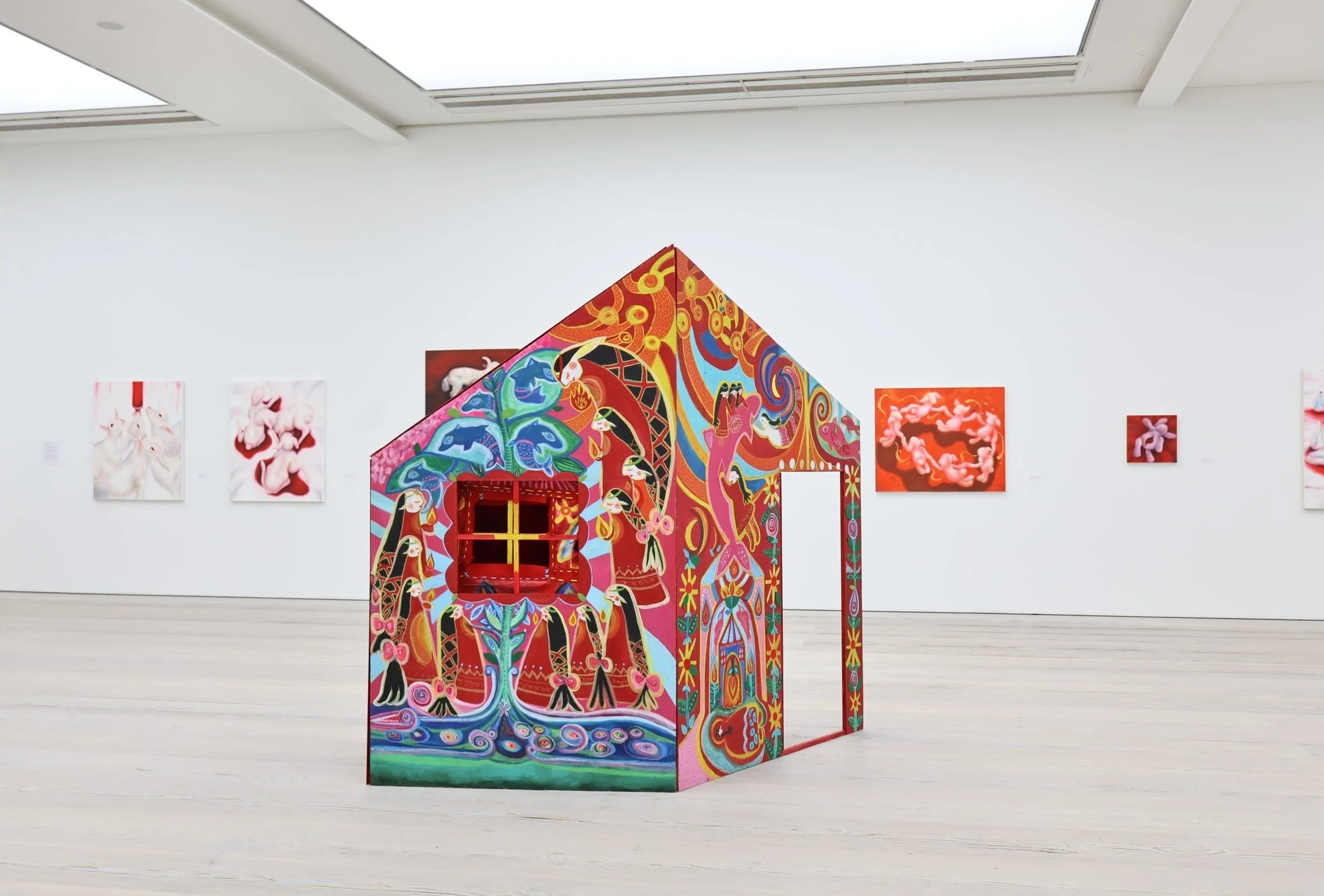10 Questions with Narmin Kassam
Canadian artist Narmin Kassam creates art as a meditative and healing practice, exploring themes of women's empowerment, gender equality, and cultural diversity. Her unique mixed-media style—developed under the mentorship of impressionist painter Gordon Harrison—combines paint and decorative paper on wood panels. Through this layered technique, she expresses feminine strength, inclusion, and the richness of cultural identity.
Kassam's work has been exhibited widely across Canada, including at the Manotick Art Gallery (2019), SEEN Exhibition featured by the Aga Khan Museum (2022), Roundhouse Centre in Vancouver (2022), Surrey Art Gallery (2023), and Summer & Grace Gallery in Toronto (2025). She will be featured in upcoming exhibitions with the Women in Arts Network and the Chicago O'Hanlon Center for the Arts, along with a solo show with the Women United Art Movement in 2025. Her collaborative public murals appear in Ottawa, Toronto, and Calgary.
Her work has been featured in Art Seen Magazine, New Visionary, Artany, Visual Art Journal, and the Arts to Hearts Project: 100 Emerging Artists of 2024. In 2024, she was longlisted for the Women United Art Prize in the Collage and Fibre Art category.
Narmin Kassam - Portrait
ARTIST STATEMENT
Narmin Kassam's Beautiful Voice series celebrates women's unbreakable strength, resilience, and vibrant diversity through layered textures, paint, and colour. The series includes a short film, an immersive installation, and mixed-media collage paintings. Born in Africa and a former refugee, Kassam feels a deep personal connection with each figure she creates. These women embody both beauty and the often-unseen struggles woven into their stories. Their voices emerge through expressions of individuality, cultural identity, and form.
The works honour women in all roles—leaders, professionals, mothers, sisters, and partners—while underscoring a collective responsibility to uplift and support them. Kassam layers decorative papers sourced from Japan, India, and beyond with paint to reflect the complexity of identity and history. The strength of the wood panels she uses echoes the resilience of each subject. The rich textures and fluid movement of the papers guide the formation of each figure and composition.
Layered skin tones, collaged fabric patterns, and traditional African-inspired clothing and head wraps pay tribute to heritage and cultural depth. Impressionistic features and postures highlight emotion through bold, simplified forms. This tactile process invites intimate engagement and reflection. For Kassam, artmaking is both meditative and spiritual—a healing practice that allows her to process life's challenges while connecting to a broader narrative of strength, solidarity, and beauty in the lives of women.
BEAUTIFUL VOICE SERIES #2, Mixed Media on wood panel, 30 x 24 in, 2021 © Narmin Kassam
INTERVIEW
First off, can you tell us about your artistic journey and how your background has influenced your work?
I came to Canada in 1973 as a political refugee from Uganda, part of the expulsion of Asians under Idi Amin. My family arrived in Vancouver with little, having left behind a thriving soda factory and the life we had built. Adjusting to a new culture, language, and way of life was difficult, but creativity became my refuge.
I grew up in an extended household of ten, navigating childhood health challenges and cultural adjustment. Art was where I found joy and solace. I spent hours drawing and experimenting with materials around the house. Visits to galleries with my aunt, along with a high school art teacher who nurtured my talent, helped me see art as something meaningful and expressive.
Despite my passion, I pursued a career in public health, as encouraged by my family, who prioritized financial stability. Still, I kept art close, attending workshops, visiting galleries, and painting in the margins of busy days as a working mother. Though self-taught, I was persistent, always experimenting with new materials, investing in good supplies, and carving out time to grow creatively.
Eight years ago, I committed more deeply to my art. I joined an art community, worked with mentors, and developed a distinctive style, paint and paper infusions on wood panels that layer texture, culture, and memory. My first series, Beautiful Voice, explored women's resilience and was exhibited both locally and internationally.
Now a part-time artist, I create daily, even if only in short bursts, while living with chronic pain. My studio is my sanctuary, and my practice is a quiet act of healing. Art helps me process life, connect with others, and offer beauty and breath in difficult times. Through every piece, I express resilience, transformation, and hope.
How did your mentorship with impressionist painter Gordon Harrison shape your style and technique?
I have been influenced by Gordon's bold, vibrant, and dynamic use of colour and fluidity, with sweeping brush strokes. He taught me to dedicate time to paint consistently, use quality tools, paints, canvases, and brushes, and develop my portfolio of work. He encouraged me to find my unique style and refine my techniques. Although Gordon is primarily an expressive landscape artist, he supported me by focusing on subjects and styles that resonated with me. He guided me to relax, loosen my brush strokes, and let go of my fears. He believed in my talent. I was the first of his students to bring paper into his studio and glue it to canvases!
BEAUTIFUL VOICE SERIES #6, Mixed Media on wood panel, 30 x 24 in, 2024 © Narmin Kassam
BEAUTIFUL VOICE SERIES #10, Mixed Media on wood panel, 30 × 20 in, 2024 © Narmin Kassam
What draws you to use mixed media, especially decorative papers and wood panels, in your practice?
My fascination with paper began as a child when I would collect scraps of wrapping paper, magazine pages, and fabric remnants to incorporate into my drawings. As I grew older, I became more intentional about my collection, seeking out specialty papers during my travels and sourcing handmade designs that carried cultural narratives within their textures and patterns.
I have always had a visceral connection with paper. My diverse collection of textured papers from Japan, India, and other regions is central to my process. I have a particular affinity for Japanese decorative paper because of its traditional hand-crafted methods that date back over a thousand years.
For me, paper is more than just a material; it is a medium of expression, history, and craftsmanship. The textures, patterns, and delicate details inspire my work, allowing me to weave different cultures and traditions into my art. Every sheet I collect holds the potential to become part of something new, adding layers, both literally and metaphorically, to the stories I tell through my paintings.
I choose to work on wood panels because they offer a strong, resilient surface that mirrors the themes I explore in my art, especially women's strength, endurance, and the rootedness of cultural identity. There's something powerful about glueing fragile, handmade papers onto a solid wooden base. The contrast between delicacy and strength becomes a metaphor in itself: even the most delicate elements can endure when supported by something solid. As I layer and adhere to each piece of paper, I think of it as an act of building resilience, honouring the invisible threads of care, labour, and history that hold us together.
How do you approach layering in your compositions, both technically and conceptually?
Like the women in my paintings, the paper is known for its vibrancy, strength, and resiliency. With their array of colours and textures, the papers ignite my creativity as I run my fingers across them, connecting deeply with their unique qualities. This tactile engagement inspires the figures and shapes in my paintings, helping me envision forms and compositions.
I emphasize the texture and colour interplay when translating inspirations into paintings, especially of human figures. I also spend time curating the specific colours and patterns that enhance the figures in my artwork. For example, designing dresses and styles based on how the light will reflect on the paper to enhance each figure.
Each paper is cut to precision to blend and enhance the painted components of the piece. Each figure owns her unique style. By carefully choosing papers and employing techniques like palette knife work and layered acrylics (heavy to gouache), with varying opacity, and mediums (vitrail, gold foil, and moulding paste), I create depth and highlight the individuality of each figure, conveying a distinct story through varied textures and hues.
BEAUTIFUL VOICE SERIES #15, Mixed Media on wood panel, 36 x 24 in, 2024 © Narmin Kassam
Your work often focuses on women's empowerment and cultural identity. Why are these themes important to you?
Women's empowerment and cultural identity are at the heart of my practice because they are deeply personal to me. As a woman of African-South Asian heritage and a former refugee, I carry layered histories of migration, resilience, and survival that shape how I see the world. These lived experiences compel me to honour the beauty, strength, and silent endurance of women whose stories are often overlooked.
I believe my art gives voice to women who might not otherwise be heard. Through layered textures, bold colours, and expressive forms, I celebrate the strength, resilience, and beauty of diverse women. My work pays tribute to those who have faced discrimination or been overlooked, highlighting their presence and power. Each piece reflects a story, often unspoken, of identity, struggle, and triumph. By showcasing women in my compositions, I aim to create space for dialogue, visibility, and empowerment. I hope that viewers feel both seen and inspired, recognizing the collective strength of women across cultures and experiences.
How does your own personal story inform the figures and narratives in your Beautiful Voice series?
My personal story is deeply woven into the Beautiful Voice series. As an African-South Asian woman and former refugee, I have lived through displacement, cultural fragmentation, and the quiet burden of rebuilding. These experiences have given me a profound respect for the strength, grace, and resilience that women carry, often in silence. The figures in this series reflect that lived truth.
Each woman I paint is shaped by this understanding. Their forms are layered with paper and paint, built slowly, just as strength is built over time. They represent not only my own journey but also the countless women I have known or imagined who hold their families and communities together through care, wisdom, and quiet leadership. Their diverse appearances are intentional; they reflect the beauty of cultural identity and the power that comes from being seen and heard in one's full humanity.
Through this series, I honour the women I come from, the ones who shaped me, and the ones I continue to learn from. It is a tribute to the inner voice that persists even when it is ignored, and to the shared strength that binds women across time and place.
You've exhibited across Canada and beyond. How has your work been received by different audiences?
I've been grateful to see my work resonate with a wide range of audiences, both in Canada and internationally. Regardless of geography, many viewers respond to the emotional depth and layered storytelling in my pieces, particularly the themes of women's strength, cultural identity, and resilience. People often tell me they feel a sense of connection, recognition, or comfort in the figures I paint, especially women who see themselves reflected in the layered textures and expressive forms.
What's been most meaningful is that the response often goes beyond the visual. Viewers share personal stories with me about their mothers, their own struggles, or their cultural journeys. The work seems to invite reflection and dialogue. That tells me it's doing what I hoped it would: creating space for healing, honouring unseen strength, and reminding us that there is beauty in our complexity.
BEAUTIFUL VOICE SERIES #17, Mixed Media on wood panel, 30 x 24 in, 2025 © Narmin Kassam
BEAUTIFUL VOICE SERIES #18, Mixed Media on wood panel, 20 x 24 in, 2025 © Narmin Kassam
What did it mean to you to be featured by institutions like the Aga Khan Museum and to be longlisted for the Women United Art Prize?
Being featured by institutions like the Aga Khan Museum and longlisted for the Women United Art Prize was incredibly humbling. These recognitions felt like a quiet acknowledgement of the years I have spent developing a practice rooted in personal history, cultural memory, and women's resilience. As someone who came to art through a healing journey after experiencing professional burnout and living with chronic pain, these moments signalled that the stories I am telling through my work matter beyond my own experience. As an artist, I often explore themes of identity, resilience, and belonging, so to have my work selected as part of a national exhibition that encourages self-representation and reflection felt incredibly validating.
The Aga Khan Museum is a place that fosters cultural dialogue and artistic excellence, and being associated with its vision underscored the significance of my voice within a larger narrative of diverse expressions. Through this opportunity, I was able to contribute to a conversation about how we, as individuals and communities, choose to be seen, how our personal stories, values, and ideals shape the way we engage with.
Similarly, the Women United Art Prize connects me to a global community of women artists who use their practice to push boundaries, tell difficult truths, and celebrate feminine strength. It encourages me to continue challenging myself, exploring new ideas, and contributing to a broader narrative where women's voices in art are acknowledged and uplifted. It affirmed that my voice and vision contributed something meaningful to the global contemporary art conversation.
These recognitions did not just validate my work; they encouraged me to keep going, to keep creating with purpose, and to continue offering spaces of reflection and beauty through my art.
Can you tell us more about your upcoming solo show with the Women United Art Movement?
I'm honoured to be preparing for my upcoming solo show with the Women United Art Movement. This online exhibition offers a unique opportunity to share my work with art enthusiasts, collectors, and curators from around the world. The show will feature my series Beautiful Voice, a deeply personal body of work that pays tribute to the silent strength, resilience, and interconnectedness of women.
As part of the exhibition, I will also be giving an Artist Talk, which will be recorded and made available for wider viewing. This talk will give me a chance to introduce myself and share my practice more fully, to share the stories behind the work, and to walk viewers through the exhibition, describing the symbolism, emotion, and intent within each piece. It is a meaningful opportunity to connect on a deeper level with audiences and to offer insight into how my materials, process, and personal journey shape the figures and narratives in my art.
I'm incredibly grateful to the Women United Art Movement for this platform. Their commitment to amplifying women's voices in contemporary art aligns so closely with my purpose as an artist. I look forward to sharing this moment of reflection and celebration with a global community.
BEAUTIFUL VOICE SERIES #19, Mixed Media on wood panel, 24 x 24 in, 2025 © Narmin Kassam
And lastly, what themes or ideas are you currently exploring in your new works?
In my current body of work, With One Voice, I am exploring the quiet but profound strength that women carry, especially the sacred connection that exists between them across generations, cultures, and shared experiences. The series is a tribute to the resilience, tenderness, and unspoken support that often go unnoticed but are deeply felt.
These women do not speak loudly, but their presence resonates with quiet force. With One Voice captures a collective hum, a rhythm of endurance and dignity. The closeness of the figures, their arms linked or bodies leaning toward one another, reflects how we hold one another up. It is in this quiet strength that I find the possibility of healing, affirmation, and restoration.
Artist’s Talk
Al-Tiba9 Interviews is a promotional platform for artists to articulate their vision and engage them with our diverse readership through a published art dialogue. The artists are interviewed by Mohamed Benhadj, the founder & curator of Al-Tiba9, to highlight their artistic careers and introduce them to the international contemporary art scene across our vast network of museums, galleries, art professionals, art dealers, collectors, and art lovers across the globe.






















